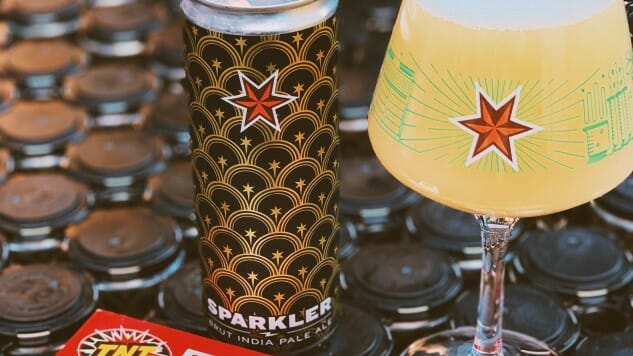Sixpoint Brewery Sparkler Brut IPA

For all the talk about brut IPA as “the next big thing” in craft beer circles, and the obvious next step in the evolution of NE-IPAs, I must be frank: I really haven’t tried many of them to date. There simply haven’t been all that many in the southeast beer market so far, but what I’ve seen hasn’t exactly instilled me with great fervor or anticipation. In truth, my experience with brut IPA to date has been almost uniformly underwhelming. The biggest problem is that beers labeled as “brut IPA” that I’ve sampled have typically been more or less indistinguishable from other modern, hazy IPAs—just as sweet, just as juice-focused and just as prone to the same successes or failings, especially when it comes to having too much hop particulate in suspension.
In short, I haven’t sampled a brut IPA that made me understand why this should be a viable offshoot to the IPA family tree.
That is, until now.
That beer is Sixpoint’s new Sparkler Brut IPA. It’s the first time I’ve sampled a beer with “brut IPA” on the label and thought “Yes, this beer is justifying the description of what brut IPA is supposed to achieve.” And perhaps more importantly, it’s the first time I’ve consumed one and then actually wanted another. This is key.
If you’ve been living under a rock—or are a normal human being and not a beer geek—then you might need a quick refresher on what “brut IPA” is supposed to be. Namely, these are hop-forward, typically hazy offshoots of Northeast IPA that trade in that style’s increasing trend toward candy sweetness and extremely full mouthfeel/”chewiness” for dry finishes, zippy carbonation and an emphasis on hop flavors without all the feeling of decadence/desserty-ness. Got that? Then let’s talk about Sparkler.
First, I must note something that I usually don’t bother to discuss, which is appearance. Suffice to say, when I first poured this into a glass, it was not exactly a pretty sight. Sparkler is hazy, yes, but it also has a watery, semi-translucence to it that is only amplified by a very light color that is somewhere between straw and tan. It looked dirty, for lack of a better word, and that’s coming from someone who finds the average NE-IPA look fairly appealing. It was notable enough that I reached out to Sixpoint, and they acknowledged that the look of the beer was something that had been heavily debated. Their words are illuminating, so I’ve included them below.